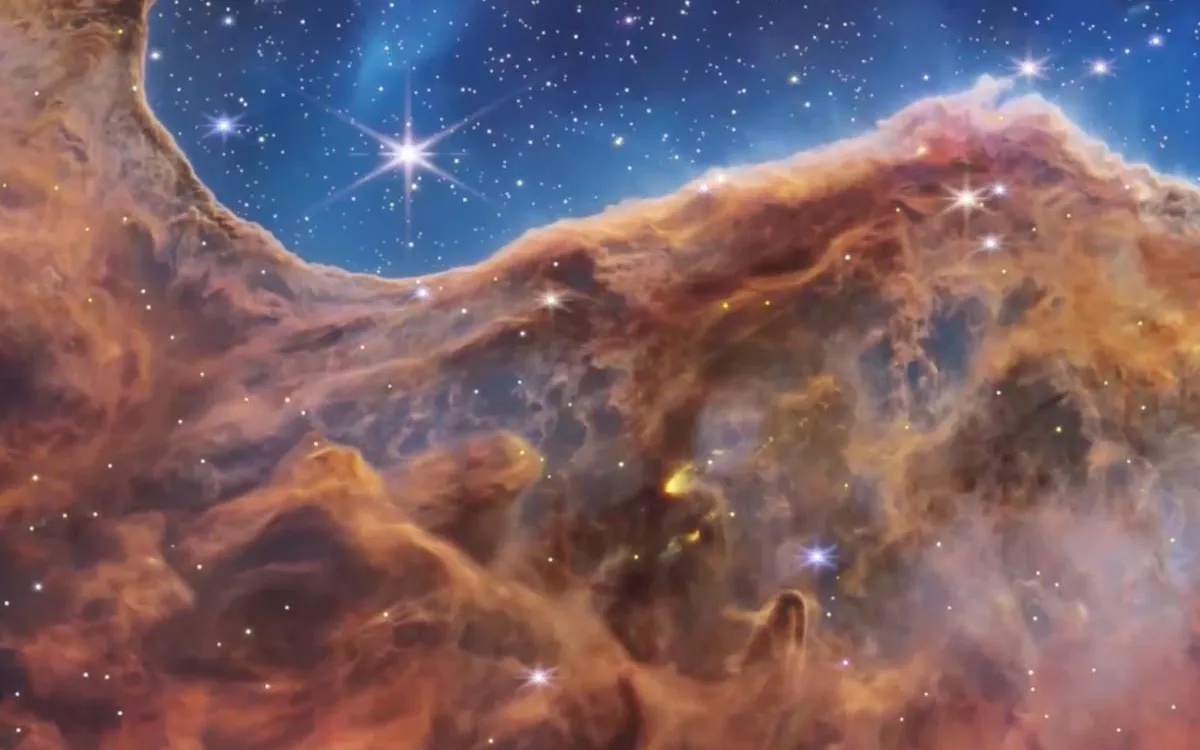
In July 2022, the James Webb Space Telescope (JWST) made a remarkable entrance into the world of astronomy, showcasing a collection of breathtaking images. Among these stunning visuals was a mesmerizing landscape known as the Cosmic Cliffs. This glittering region, which is a hub for star birth, is now the focus of a new 3D visualization derived from JWST data. Titled “Exploring the Cosmic Cliffs in 3D,” this visualization has been crafted by NASA’s Universe of Learning and breathes new life into the iconic imagery captured by the Webb.
The unveiling of this captivating 3D visualization coincides with a special event hosted by the International Planetarium Society. This event commemorates the 100th anniversary of the first public planetarium located in Munich, Germany. The Cosmic Cliffs, which resemble a majestic landscape of “mountains” and “valleys,” are actually part of the nebula Gum 31. Within this nebula lies a young star cluster known as NGC 3324. Both Gum 31 and NGC 3324 are integral components of the expansive Carina Nebula Complex, a significant region for star formation.
The intricate landscape of the Cosmic Cliffs has been carved by the intense ultraviolet light and stellar winds emanating from the stars in NGC 3324. These forces have created a cavernous area within Gum 31, and a portion of this vast bubble is visible above the Cosmic Cliffs. The cliffs exhibit a misty appearance, with “steam” seemingly rising from the celestial mountains. However, these wisps are actually hot, ionized gas and dust being expelled from the nebula due to the relentless bombardment of ultraviolet radiation.
Viewers with a keen eye may also notice bright yellow streaks and arcs within the Cosmic Cliffs, which signify outflows from young, still-forming stars nestled within the nebula. The latter segments of the visualization take viewers on a journey past a prominent protostellar jet located in the upper right of the image. This impressive visualization was produced for NASA by the Space Telescope Science Institute (STScI) in collaboration with Caltech/IPAC, and developed by the AstroViz Project of NASA’s Universe of Learning.
The visualization is part of a longer, narrated video designed to engage broad audiences, including youth, families, and lifelong learners. It provides a direct connection to the science and scientists behind NASA’s Astrophysics missions. This innovative video allows viewers to explore fundamental scientific questions, understand the process of scientific discovery, and embark on their own journey to uncover the mysteries of the universe.
“Bringing this amazing Webb image to life helps the public to comprehend the three-dimensional structure inherent in the 2D image, and to develop a better mental model of the universe,” remarked Frank Summers, principal visualization scientist at STScI and leader of the AstroViz Project. NASA’s Universe of Learning also offers additional resources, such as a dedicated Carina Nebula Complex resource page and ViewSpace, a video exhibit currently showcased at nearly 200 museums and planetariums across the United States. These initiatives allow visitors to delve deeper into the images produced by space telescopes and engage with interactive tools available in museums and planetariums.
The James Webb Space Telescope stands as the world’s premier space science observatory, dedicated to unraveling the mysteries of our solar system, investigating distant worlds orbiting other stars, and probing the enigmatic structures and origins of our universe. The Webb program is a collaborative international effort led by NASA, alongside its partners, the European Space Agency (ESA) and the Canadian Space Agency (CSA).
NASA’s Universe of Learning is an integral component of the NASA Science Activation program, part of the Science Mission Directorate at NASA Headquarters. This program connects NASA science experts with real content and experiences, fostering deeper understanding of our world and beyond. Through its resources and experiences, NASA’s Universe of Learning empowers youth, families, and lifelong learners to explore essential scientific questions, engage in the scientific process, and discover the universe for themselves.
To learn more about the James Webb Space Telescope and its groundbreaking discoveries, visit: NASA's official website.